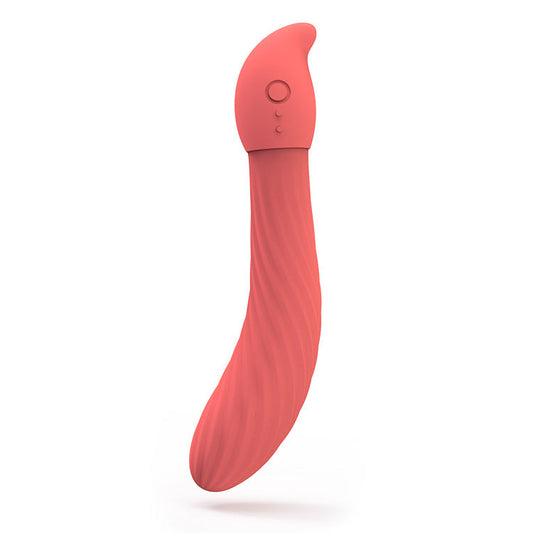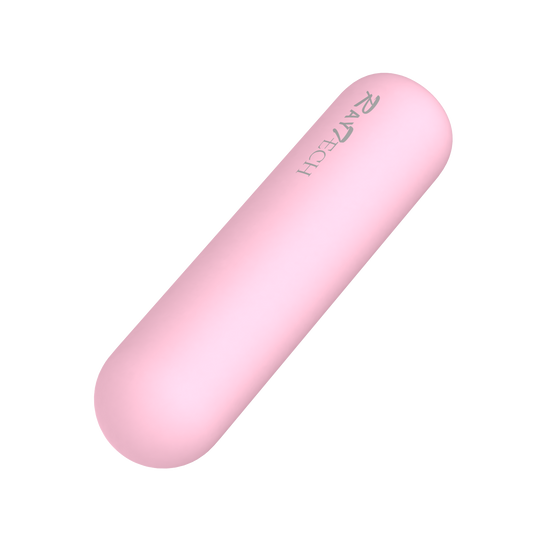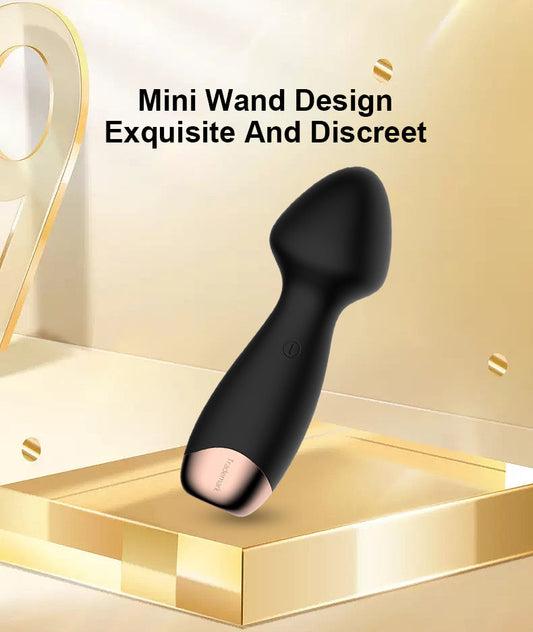
Wie man einen Stabvibrator benutzt – Eine gewagte und professionelle Anleitung
Der Zauberstab-Vibrator ist bei vielen Frauen und Paaren sehr beliebt. Er kann helfen, schnell zum Orgasmus zu kommen und eröffnet unzählige Möglichkeiten für Vorspiel und sexuelle Erlebnisse mit dem Partner.
Wir hören oft Fragen wie: „Wird es meine Empfindsamkeit verringern?“ „Meine Frau benutzt oft einen Stabvibrator. Wird sie das Interesse an mir verlieren?“ „Wie genau benutze ich einen Stabvibrator?“ Falls Sie unsicher oder verwirrt sind, beantwortet dieser Artikel möglicherweise all Ihre Fragen.
1. Ursprung und Entwicklung des Stabvibrators
Der Stabvibrator ist für viele ein zeitloser Klassiker, doch seine Ursprünge liegen in einem viel praktischeren Zweck. Er wurde 1968 von Hitachi erstmals vorgestellt und ursprünglich als Muskelmassagegerät zur Linderung von Verspannungen in Schultern, Nacken und Rücken entwickelt. Die Erfinder ahnten damals wohl kaum, dass dieses Gerät zu einem revolutionären Werkzeug im Bereich des sexuellen Wohlbefindens werden würde.
Der Übergang zur Klitorisstimulation
Frauen entdeckten schnell, dass die kraftvollen Vibrationen des Massagegeräts ideal zur Klitorisstimulation geeignet waren, und so begann sich der Zauberstab-Vibrator von einem Produkt zur Muskelentspannung zu einem festen Bestandteil der Sexspielzeugindustrie zu entwickeln. In den 1970er-Jahren propagierte die renommierte Sexualpädagogin Betty Dodson den Zauberstab-Vibrator als Hilfsmittel für weibliche Masturbation und sexuelle Selbstbestimmung. Sie betonte, dass sexuelle Lust ein natürlicher und gesunder Bestandteil des Lebens sei , und der Zauberstab-Vibrator wurde zum Symbol für sexuelle Befreiung und Entdeckungslust .
Kontinuierliche Weiterentwicklung des Zauberstab-Vibrators
Seit seinen bescheidenen Anfängen hat der Stabvibrator eine bemerkenswerte Entwicklung durchlaufen. Moderne Modelle wie der Texture Double Pleasure Wand Vibrator bieten heute vielfältige Vibrationsmodi , einstellbare Frequenzen und Funktionen wie kabelloses oder wiederaufladbares Design . Ergonomische Silikonaufsätze sorgen zudem für ein komfortables und lustvolles Erlebnis. Diese kontinuierliche Innovation unterstreicht, wie Technologie und das Bewusstsein für sexuelle Gesundheit zusammenwirken, um das Benutzererlebnis zu verfeinern und zu verbessern. Dadurch ist der Stabvibrator sowohl für Solo- als auch für Partnerspiele sehr beliebt.
Warum der Zauberstab-Vibrator die sexuelle Gesundheit revolutioniert
Der Stabvibrator besticht durch seine Vielseitigkeit und die kraftvollen, gleichmäßigen Vibrationen. Ob Sie intensive Klitorisstimulation suchen oder neue erogene Zonen entdecken möchten – dieses Gerät bietet einzigartige Vorteile, die andere Vibratoren oft nicht bieten können. Seine lange Geschichte und die kontinuierliche Weiterentwicklung unterstreichen den wachsenden Fokus auf sexuelle Gesundheit , persönliches Vergnügen und Wohlbefinden und machen ihn zu einem unverzichtbaren Hilfsmittel für sexuelles Wohlbefinden.
Der Zauberstabvibrator ( Texture Double Pleasure Wand Vibrator ) wurde über die Jahre hinweg kontinuierlich verbessert.
Tabelle 1: Entwicklungszeitplan des Stabvibrators
| Jahr | Produkttyp | Merkmale | Hauptverwendung | Quelle |
|---|---|---|---|---|
| 1968 | Hitachi Original | Kabelgebunden, einzelne starke Vibration | Muskelmassage / Weibliche Masturbation | Wikipedia |
| 1970er Jahre | Förderung der Sexualaufklärung | Fokus auf Klitorisstimulation | Weibliche Masturbation | Der Guardian |
| 2000er Jahre | Multimode-Funk | Mehr als 10 Frequenzen, Silikonkopf | Massage & sexuelle Lust | Glanz |
| 2020er Jahre | Intelligente App-Steuerung | Anpassbare Vibration | Ferninteraktion eines Paares | Offizielle Markendaten |
Ausführliche Erklärung: Moderne Stabvibratoren bieten nuancierte Stimulation. Niedrige Stufen kitzeln, mittlere Stufen sorgen für ein ausgewogenes Verhältnis von Komfort und Vergnügen, und hohe Stufen bieten pulsierende Intensität. Kabelloses und ergonomisches Design gewährleisten Komfort und Mobilität für die Solo- oder Partnernutzung.
2. Anwendungsbereiche für Stabvibratoren
- Klitorisstimulation: Die Klitoris besitzt über 8.000 Nervenendigungen. Hochfrequente Vibrationen stimulieren diese effizient und erzeugen so ein schnelles, intensives Lustempfinden ( Healthline ).
- Indirekte G-Punkt-Stimulation: Durch Vibration des Klitoris-Vagina-Komplexes wird der G-Punkt indirekt stimuliert, wodurch mehrschichtige Lustgefühle entstehen und das Potenzial zum Ejakulieren freigesetzt wird.
- Muskelentspannung: Zur Muskelentspannung an Schultern, Nacken, Rücken oder Beinen anwenden. Entspannte Muskeln verbessern die sexuelle Erregbarkeit.
- Brustvergnügen: Die Stimulation der Brustwarzen steigert die Erregung und die Orgasmusfähigkeit sowohl bei Männern als auch bei Frauen.
- Interaktion zwischen Paaren: Beim Vorspiel oder Geschlechtsverkehr kann ein Vibrator die Klitoris stimulieren und so die Erregung und die sexuelle Kommunikation steigern.
- Anwendung bei Männern: Männer können den Zauberstab am Penis, Hodensack, Damm oder an der Prostata anwenden, um intensive Lust zu empfinden ( Healthline ).
- LGBT-Paare: Die Verwendung eines Vibrators ermöglicht simultane Orgasmen und steigert so die Intimität ( Well+Good ).
Tabelle 2: Anwendungsszenarien für Stabvibratoren
| Szenario | Empfohlener Modus | Erwarteter Effekt | Anmerkungen | Quelle |
|---|---|---|---|---|
| Klitoris | Niedrig bis mittel | Schneller Höhepunkt, erhöhte Empfindlichkeit | Beginnen Sie mit einer niedrigen Vibrationszahl und vermeiden Sie zu starke Vibrationen. | PMC |
| Indirekter G-Punkt | Mittlere + Winkeleinstellung | Kombinierte Klitoris- und G-Punkt-Stimulation | Gleitmittel verwenden, langsam erkunden | Healthline |
| Schulter/Nacken | Mittel bis hoch | Lindert Muskelermüdung | Vermeiden Sie lange Belichtungszeiten an einem Ort. | Markenhandbuch |
| Paarspiel | Beliebig | Steigere die Erregung beim Vorspiel | Rhythmus und Wohlbefinden vermitteln | Gut+ |
| Stimulation des Mannes | Niedrig bis mittel, auf Penis/Prostata | Steigert das Vergnügen, intensiverer Orgasmus | Mäßiger Gebrauch, Reibung beachten | Healthline |
| LGBT-Paare | Mehrere | Gleichzeitige Orgasmen | Winkel und Rhythmus anpassen | Gut+ |

3. Anwendungsschritte für den Stabvibrator
Um Ihren Zauberstab-Vibrator optimal zu nutzen, ist die richtige Anwendung unerlässlich. Diese Anleitung hilft Ihnen bei der Reinigung und Schmierung Ihres Geräts. Sie zeigt Ihnen außerdem, wie Sie es sicher aufbewahren. So bleibt Ihr Gerät sauber und leistungsstark.
3.1. Reinigung Ihres Zauberstab-Vibrators
Reinigen Sie Ihren Zauberstab-Vibrator vor und nach jeder Benutzung mit warmem Wasser oder einem milden Sexspielzeugreiniger . Dies gewährleistet nicht nur die Hygiene Ihres Spielzeugs, sondern sorgt auch für ein angenehmes und sicheres Erlebnis. Regelmäßige Reinigung beugt Bakterienbildung vor und verlängert die Lebensdauer des Vibrators.
Profi-Tipp : Reinigen Sie Ihre Spielzeuge immer sofort nach Gebrauch, um Rückstände zu vermeiden. So stellen Sie sicher, dass sie für Ihr nächstes Erlebnis bereit sind.
3.2. Schmierung für verbesserte Empfindung
Für maximalen Genuss verwenden Sie bei der Benutzung Ihres Zauberstab-Vibrators immer ein Gleitmittel auf Wasserbasis . Gleitmittel auf Wasserbasis reduziert die Reibung, verstärkt das Gefühl und den Komfort und sorgt dafür, dass der Vibrator sanft über Ihre Haut gleitet. Außerdem beugt es Hautirritationen vor.
Wichtig : Verwenden Sie keine öl- oder silikonbasierten Gleitmittel auf Silikon-Vibratorköpfen . Diese können das Material beschädigen und den Verschleiß Ihres Vibrators beschleunigen.
3.3. Einschalten und Einstellen der Vibration
Bei der Verwendung des Stabvibrators sollten Sie immer mit einer niedrigen Frequenz beginnen und die Intensität allmählich steigern. Das Design des Stabs führt Sie auf eine sinnliche Reise , nehmen Sie sich also Zeit und genießen Sie die verschiedenen Vibrationsmodi. So können Sie die unterschiedlichen Empfindungen erkunden, ohne zu einem sofortigen Orgasmus zu gelangen.
Tipp : Beginnen Sie langsam und experimentieren Sie mit verschiedenen Vibrationseinstellungen, um herauszufinden, was für Ihren Körper am besten funktioniert.
3.4. Den eigenen Körper erkunden
Die Vibration des Vibrators kann verschiedene empfindliche Bereiche stimulieren. Dazu gehören Klitoris , Vulva , Innenseiten der Oberschenkel , G-Punkt und Anus . Beginnen Sie mit Bereichen wie Ihren Brüsten oder Innenseiten der Oberschenkel, um sich aufzuwärmen, bevor Sie sich auf empfindlichere Regionen konzentrieren. Sobald Sie sich wohler fühlen, experimentieren Sie mit verschiedenen Positionen und Intensitäten, um herauszufinden, was sich für Sie am besten anfühlt.
Profi-Tipp : Scheuen Sie sich nicht, Neues auszuprobieren. Jeder Körper ist anders. Ein Stabvibrator kann Ihnen helfen, neue Lustquellen zu entdecken.
3.5. Nach Gebrauch: Ordnungsgemäße Reinigung und Lagerung
Nach Gebrauch ist es wichtig, den Stabvibrator gründlich zu reinigen. Waschen Sie ihn mit warmem Wasser oder einem Sexspielzeugreiniger, um sicherzustellen, dass er frei von Gleitmittelresten und Körperflüssigkeiten ist. Trocknen Sie ihn vollständig ab, bevor Sie ihn an einem kühlen, trockenen Ort aufbewahren. Die richtige Aufbewahrung verhindert Beschädigungen und Schmutzablagerungen und sorgt dafür, dass Ihr Vibrator länger einwandfrei funktioniert.
Wichtig : Schützen Sie Ihre Spielzeuge vor direkter Sonneneinstrahlung und Hitze. Lassen Sie sie nicht in feuchten Umgebungen liegen, da Feuchtigkeit das Material beschädigen kann.
4. Gängige Sexstellungen und Zauberstabtechniken
| Position | Zauberstab-Nutzung | Vorteile | Tipps |
|---|---|---|---|
| Missionar | Platziere den Zauberstab auf der Klitoris, während der Partner den Oberkörper stützt. | Klassisch, ermöglicht Augenkontakt | Ein Kissen unter den Hüften verbessert den Kontakt |
| Frau an der Spitze | Halten Sie den Zauberstab selbst, passen Sie den Winkel an | Vergnügen im eigenen Tempo, rhythmische Freiheit | Halten Sie den Zauberstabfuß vorsichtig fest. |
| Hundestil | Zauberstab an Klitoris oder Schamlippen | Gleichzeitige Klitoris- und Penetrationsstimulation | Kissen unter dem Bauch für mehr Komfort |
| Seitlich liegend | Klemmstab zwischen den Oberschenkeln oder Partner hält | Geeignet für lange Sessions | Körper entspannen, Beine leicht beugen |
| 69 | Zauberstab an der Klitoris der Partnerin | Gegenseitiges Vergnügen | Sichere Winkel, Verletzungen vermeiden |
- Kombinieren Sie „Vibration + Druck“: sanft, dann allmählich stärker.
- Verändern Sie den Winkel, um die optimale Stimulation zu finden.
- Hohe Frequenz für kurze Intervalle; niedrige Frequenz für längere Sitzungen.
- Gib den Zauberstab an deinen Partner weiter, um gemeinsames Vergnügen zu teilen.
- LGBT-Paare: Synchronisierte Nutzung steigert die Intimität.
5. Sicherheit bei Langzeitanwendung
Häufiger Gebrauch verringert die Empfindlichkeit nicht. Studien zeigen, dass Vibratoren keine Nervenschäden oder dauerhaften Empfindungsverlust verursachen ( PMC ).
Kurzfristig: Nach längerer oder häufiger Anwendung kann es zu vorübergehender Taubheit kommen. Die Beschwerden klingen innerhalb von Minuten oder Stunden wieder ab.
Langfristig: Regelmäßiger Gebrauch verbessert das Körperbewusstsein und die Orgasmusfähigkeit ( Healthline ).
Auswirkungen auf Paare: Die Verwendung eines Vibrators steigert das Vorspiel und den Orgasmus und verbessert die sexuelle Verbindung ( Well+Good ).
- 10-30 Minuten pro Sitzung
- Ruhepausen zwischen den Hochfrequenzimpulsen
- Schmiermittel verwenden
- Rotationsmodi/Positionen
- Beenden Sie die Übung, wenn Schmerzen oder Taubheitsgefühl auftreten.
6. Psychologische und physiologische Mechanismen
Die Verwendung eines Stabvibrators dient nicht nur dem körperlichen Vergnügen. Sie beeinflusst auch psychologische und physische Faktoren, die Ihr sexuelles Erlebnis intensivieren können. Wenn Sie wissen, wie diese Mechanismen funktionieren, können Sie Ihren Vibrator noch mehr genießen. Dies kann zu größerer Zufriedenheit und tieferer Verbundenheit führen.
Physiologische Mechanismen: Wie Vibrationen das Vergnügen steigern
Die starken Vibrationen eines Stabvibrators stimulieren die Nerven der Klitoris und des G-Punktes . Diese Aktivierung regt wichtige Bereiche Ihres Körpers an, die mit sexueller Lust in Verbindung stehen.
Diese Vibrationen senden Signale an das Gehirn. Dadurch werden Glückshormone wie Dopamin und Oxytocin freigesetzt. Diese Hormone können das Gefühl von Glück und Nähe verstärken. Durch die gleichmäßige und intensive Stimulation verhilft der Stabvibrator zu schnelleren und intensiveren Orgasmen.
Profi-Tipp : Experimentieren Sie mit verschiedenen Vibrationsfrequenzen, um die perfekte Intensität für Ihren Körper zu finden. Niedrige Frequenzen wirken sanft, während hohe Frequenzen zu intensiveren Empfindungen führen und Ihnen so ein individuelles Erlebnis ermöglichen.
Psychologische Mechanismen: Steigerung des sexuellen Selbstbewusstseins
Auf psychologischer Ebene bietet die Verwendung eines Stabvibrators mehr als nur körperliches Vergnügen; sie fördert das sexuelle Selbstbewusstsein . Indem du deinen Körper erkundest, lernst du, wie verschiedene Vibrationen auf dich wirken.
Das hilft Ihnen, Ihre persönlichen Wünsche und Vorlieben besser zu verstehen. Diese Selbsterkenntnis steigert Ihre sexuelle Zufriedenheit . Außerdem hilft sie Ihnen, besser mit Ihrem Partner darüber zu sprechen, was sich gut anfühlt.
Tipp: Die Verwendung eines Stabvibrators zur Erkundung des eigenen Körpers kann das Selbstvertrauen in Bezug auf die eigenen sexuellen Bedürfnisse stärken. Dadurch fällt es leichter, diese Bedürfnisse mit dem Partner zu teilen.
Interaktion in der Partnerschaft: Stärkung von Intimität und Verbundenheit
Bei gemeinsamer Nutzung kann ein Stabvibrator die Intimität in einer Partnerschaft deutlich steigern. Indem beide Partner den Vibrator abwechselnd verwenden, können sie ihre Lust besser aufeinander abstimmen. Dies führt zu einem intensiveren und lustvolleren Erlebnis. Für LGBT-Paare kann der Stabvibrator Raum für gemeinsame Erkundungen schaffen und so die körperliche und emotionale Verbindung vertiefen.
Die gemeinsame Nutzung eines Stabvibrators fördert Kommunikation und Intimität , da Partner über Vorlieben, Rhythmus und Empfindungen sprechen. Diese Dynamik ermutigt zu offeneren und ehrlicheren Gesprächen über sexuelle Wünsche, stärkt das Vertrauen und festigt die Bindung zwischen den Partnern.
Profi-Tipp : Verwenden Sie den Stabvibrator beim Vorspiel oder beim Sex. Das kann das Vergnügen steigern und Ihre Bindung zu Ihrem Partner stärken. ( Well+Good )
7. FAQ: Lustige und gewagte Fragen
Frage 1: Werde ich durch die Verwendung eines Stabvibrators weniger empfindlich?
A: Absolut nicht! Nach häufiger Anwendung kann es vorübergehend zu Taubheitsgefühlen kommen, aber Ihre Nerven erholen sich schnell. Regelmäßige Anwendung verbessert das sexuelle Empfinden ( PMC ).
Frage 2: Können auch Männer Zauberstab-Vibratoren benutzen?
A: Ja! Vibrationen mit einem Vibrator am Penis, Hodensack, Damm oder an der Prostata können intensive Lustgefühle hervorrufen und Orgasmen verstärken ( Healthline ).
Frage 3: Kann mein Partner eifersüchtig werden, wenn ich einen Zauberstab benutze?
A: Ganz und gar nicht. Vibratoren steigern die Intimität. Paare stellen oft fest, dass synchrones Vibratorspiel sie einander näher bringt ( Well+Good ).
Frage 4: Kann der Zauberstab in mehreren Positionen verwendet werden?
A: Absolut. Missionarsstellung, Frau oben, Doggystyle, Seitenlage, 69 – alles ist möglich. Variiere Winkel und Häufigkeit für maximalen Genuss.
Frage 5: Ist es sicher für LGBT-Paare?
A: Ja! Die Verwendung eines Vibrators ermöglicht einen gemeinsamen Orgasmus und steigert die Intimität bei gleichgeschlechtlichen Paaren ( Well+Good ).
Frage 6: Wie reinige und lagere ich es sicher?
A: Vor und nach Gebrauch mit warmem Wasser oder Spielzeugreiniger abwaschen. Kühl und trocken lagern. Für ein angenehmes Spielerlebnis ein Gleitmittel auf Wasserbasis verwenden.
8. Zusammenfassung
- Stimuliert die Klitoris und indirekt den G-Punkt.
- Funktioniert mit mehreren Stellungen (Missionarsstellung, Frau oben, Doggystyle, Seitenlage, 69)
- Geeignet für Frauen, Männer und LGBT-Paare
- Die Langzeitanwendung verringert die Empfindlichkeit nicht.
- Befolgen Sie die Hygiene- und Sicherheitsrichtlinien.
- Geeignet für Solo- und Partnerspiele und bietet sicheres, effektives sexuelles Vergnügen.











